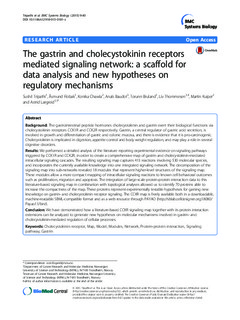The gastrin and cholecystokinin receptors mediated signaling network: a scaffold for data analysis and new hypotheses on regulatory mechanisms
Tripathi, Sushil; Flobak, Åsmund; Chawla, Konika; Baudot, Anaïs; Bruland, Torunn; Thommesen, Liv; Kuiper, Martin Tremen R.; Lægreid, Astrid
Journal article, Peer reviewed
Permanent lenke
http://hdl.handle.net/11250/2358272Utgivelsesdato
2015Metadata
Vis full innførselSamlinger
- Institutt for biologi [2596]
- Institutt for klinisk og molekylær medisin [3554]
- Publikasjoner fra CRIStin - NTNU [38294]
Sammendrag
Background: The gastrointestinal peptide hormones cholecystokinin and gastrin exert their biological functions via
cholecystokinin receptors CCK1R and CCK2R respectively. Gastrin, a central regulator of gastric acid secretion, is
involved in growth and differentiation of gastric and colonic mucosa, and there is evidence that it is pro-carcinogenic.
Cholecystokinin is implicated in digestion, appetite control and body weight regulation, and may play a role in several
digestive disorders.
Results: We performed a detailed analysis of the literature reporting experimental evidence on signaling pathways
triggered by CCK1R and CCK2R, in order to create a comprehensive map of gastrin and cholecystokinin-mediated
intracellular signaling cascades. The resulting signaling map captures 413 reactions involving 530 molecular species,
and incorporates the currently available knowledge into one integrated signaling network. The decomposition of the
signaling map into sub-networks revealed 18 modules that represent higher-level structures of the signaling map.
These modules allow a more compact mapping of intracellular signaling reactions to known cell behavioral outcomes
such as proliferation, migration and apoptosis. The integration of large-scale protein-protein interaction data to this
literature-based signaling map in combination with topological analyses allowed us to identify 70 proteins able to
increase the compactness of the map. These proteins represent experimentally testable hypotheses for gaining new
knowledge on gastrin- and cholecystokinin receptor signaling. The CCKR map is freely available both in a downloadable,
machine-readable SBML-compatible format and as a web resource through PAYAO (http://sblab.celldesigner.org:18080/
Payao11/bin/).
Conclusion: We have demonstrated how a literature-based CCKR signaling map together with its protein interaction
extensions can be analyzed to generate new hypotheses on molecular mechanisms involved in gastrin- and
cholecystokinin-mediated regulation of cellular processes.
